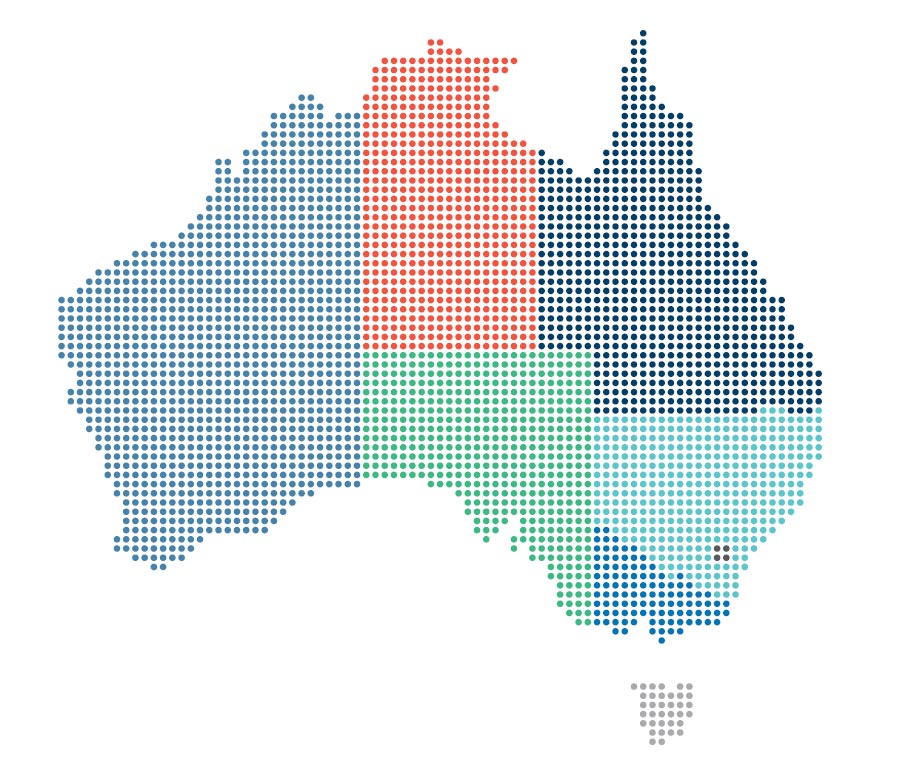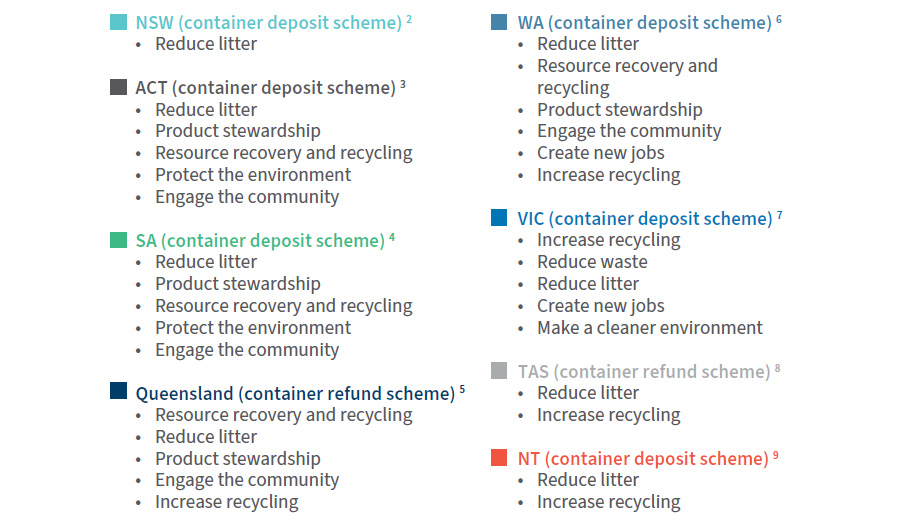Improving Australia’s Container Refund Schemes
Insights Series on Container Refund Schemes and Their Role in the Circular Economy
-
August 09, 2022
DownloadsDownload Article
-
Container refund schemes across Australia contribute to the circular economy by encouraging people to recycle drink bottles and reduce litter on our streets. Governments are currently looking for ways to improve their effectiveness. Even South Australia, which has one of the most successful and longest-running schemes in Australia,1 has identified ways to enhance its approach.
The purpose of container refund schemes
State and territory governments use container refund schemes to pursue a range of objectives – not all of them environmental (see Figure 1). These objectives influence how we should measure the effectiveness of these schemes.
Figure 1


Opportunities to improve scheme performance
Various options have been proposed to improve participation in container refund schemes including:
- making it easier to return containers
- increasing the value of the refund
- adding more types of containers to the scheme
- harmonising schemes across jurisdictions.
Making it easier to return containers
One way to improve participation is to minimise the costs consumers face by making it easier to return their containers. Currently, not all people have easy access to container collection points – particularly those who live in regional areas. For instance, while 98 per cent of electorates in Queensland have collection points, someone living in Amaroo would have to drive a minimum of four hours to reach one.10 Of course, making it easier to access collection points can be costly. Nevertheless, if a policy maker is looking to engage their community through a container scheme as one of their primary aims, they may be willing to trade off some scheme efficiency to provide more collection points in rural or remote locations.
Increasing the value of the refund
Alternatively, participation could be improved by increasing the benefits consumers receive when they return containers. Some consumers are motivated to participate in container refund schemes because they want improved environmental outcomes, whereas others want to see a monetary return. There are some doubts about whether a 10-cent refund is enough to encourage participation.11 In 2008–09, South Australia increased the deposit value from 5 cents to 10 cents and return rates appeared to increase in response.12 With inflation, the real value of refunds from container refund schemes decreases over time. For this reason, such schemes may need to be reset periodically to maintain an adequate incentive.
Adding more types of containers to the scheme
Container refund schemes have historically focused on containers that are less likely to be consumed at home and thus are more likely to end up as litter – soft drink cans, beer bottles and small flavoured milk or juice containers. While this may reduce litter, broadening the range of containers included in a scheme might help increase recycling, better promoting a circular economy. Expanding container refund schemes to include all beverage containers might also reduce confusion and the time and labour costs of sorting containers before returning them. The downside? Expanding container refund schemes to include larger bottles would likely be opposed by beverage manufacturers who would find their products subject to container refund levies for the first time.
Wine and spirit bottles have traditionally been excluded from container refund schemes because they make up a small proportion of the litter stream – a 2021 KESAB survey in South Australia counted 7,821 litter items across 151 sites, of which only three were wine or spirit bottles.13 However, glass is a higher-value material that is easily recyclable, so the exclusion of larger glass bottles from container refund schemes is inconsistent with the principles of the circular economy. An audit of kerbside bins undertaken in South Australia found that wine and spirit containers comprised on average 13 per cent of the weight of material in co-mingled bins each week.14 A container refund scheme could be used to encourage more people to separate glass bottles out of co-mingled recycling to create a higher quality stream of recycled glass material.
Harmonising schemes across jurisdictions
The kinds of containers that are eligible for most Australian schemes have been modelled on those eligible in the original South Australian scheme. However, each scheme in each Australian state and territory has also been created to pursue slightly different policy objectives (see Figure 1). This has resulted in some small but significant differences. These differences increase administrative costs for beverage manufacturers and suppliers that must manage ‘export’ of their products between states and territories. A supplier operating across multiple jurisdictions, for instance, faces different payment models and payment terms. Harmonising schemes, or implementing a national scheme, may therefore help to improve scheme efficiency and better achieve a circular economy.
How we can help
When weighing up how best to design or improve a container refund scheme, some principles need to be applied:
- Ensure the design of the scheme is aligned with its objectives.
- Consult with stakeholders to understand how the scheme impacts them, and any possible improvements.
- Clearly make a case for change.
- Explore opportunities to simplify or harmonise across jurisdictions.
At FTI Consulting, our Economic & Financial Consulting team can guide you through the policy evaluation process and ensure that a container refund scheme, or other waste policy, is designed to efficiently and effectively meet its objectives.
Footnotes:
1: Environment Protection Authority South Australia 2021, Improving South Australia’s recycling makes cents – A discussion paper to review SA’s container deposit scheme, September 2021.
2: Independent Pricing and Regulatory Tribunal (IPART) 2019, NSW container deposit scheme, p. 12.
3: Independent Competition and Regulatory Commission (ICRC) 2019, Container Deposit Scheme Price Monitoring (Final Report), p. 1.
4: Environment Protection Authority South Australia 2021, Improving South Australia’s recycling makes cents – A discussion paper to review SA’s container deposit scheme, September 2021, p. 17.
5: Queensland Productivity Commission 2020, Container refund scheme price monitoring review – final report, p. 2.
6: Western Australian Government 2022, WA container deposit scheme 2022.
7: Victorian Government 2022, Container deposit scheme.
8: Department of Natural Resources and Environment Tasmania 2022, Container refund scheme.
9: Northern Territory Environment Protection Authority 2014, Review of containers regulated under the NT Container Deposit Scheme.
10: COEX 2022, Queensland celebrates record 350 container refund points, media release, 12 April.
11: Environment Protection Authority South Australia 2021, Improving South Australia’s recycling makes cents – A discussion paper to review SA’s container deposit scheme, September 2021, p. 46.
12: Environment Protection Authority South Australia 2021, Improving South Australia’s recycling makes cents – A discussion paper to review SA’s container deposit scheme, September 2021, p. 46.
13: KESAB 2021, Litter Strategy Monitoring Wave 81 – May 2021 Report, May 2021.
14: Environment Protection Authority South Australia 2021, Improving South Australia’s recycling makes cents – A discussion paper to review SA’s container deposit scheme, September 2021, p. 25.
Related Insights
Published
August 09, 2022
 Key Contacts
Key Contacts
Managing Director
Director
Senior Consultant


